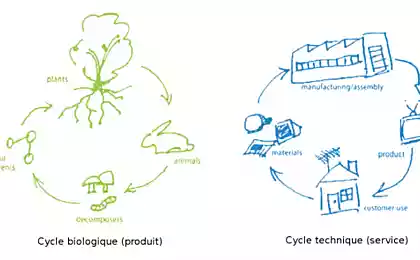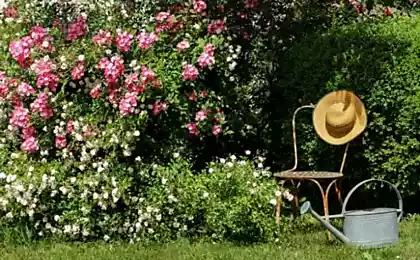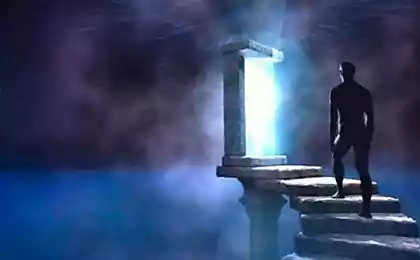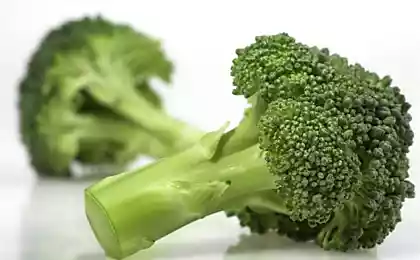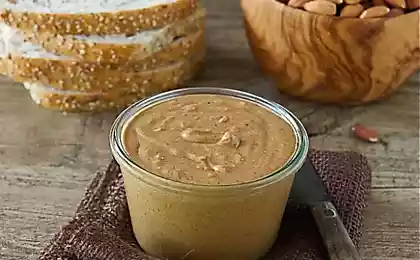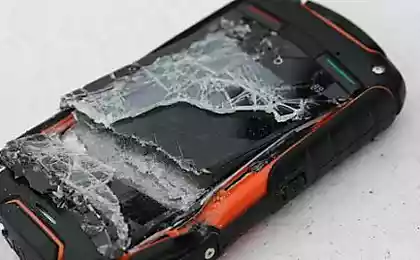738
10 artificial materials with unique properties
The variety of nature is boundless, but there are materials that would not appear to light without human involvement. We bring you the 10 substances created by human hands and showing fantastic properties.
1. One-way bulletproof steklo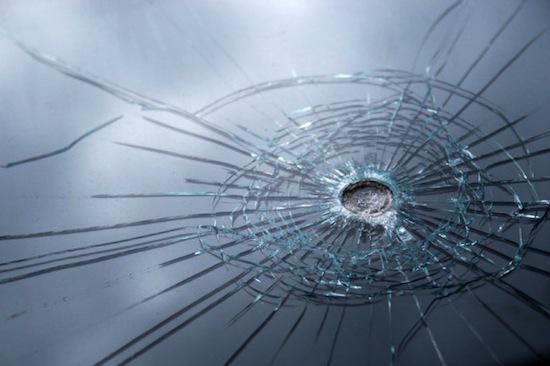
In the richest people have problems judging by the growing sales of this material, they need bulletproof glass, which would have saved lives but did not stop them to shoot.
This glass stops a bullet on the one hand, but at the same time transmits the other - this unusual effect is a "sandwich" of fragile acrylic layer and a soft elastic polycarbonate: pressurized acrylic behaves like a very solid material, and in contact with the bullet he it dampens the energy of cod while. This allows the cushioning layer withstand the impact of bullets and shrapnel acrylic, without destroying.
When fired, the other side of the resilient polycarbonate bullet passes through a stretching and destroying fragile acrylic layer that leaves no further barrier for bullets, but do not shoot too often, because of this, to protect the formed hole.
2. Liquid glass
There was a time when the dishwashing detergent did not exist - people are treated with soda, vinegar, silver sand, friction or wire brush, but the new facility will help save a lot of time and effort and generally leave washing dishes in the past. "Liquid glass" includes silicon dioxide, is formed by reacting with water or ethanol material which then dries up, turning into a fine (more than 500 times thinner than a human hair) of the elastic layer, sverhstoykogo, non-toxic and moisture repellent glass.
With such material eliminates the need for cleaning and disinfecting agents, since he is able to perfectly protect the surface from germs: bacteria on the surface of the dish or just shells isolated. The invention also finds application in medicine, for sterilized instruments can now be only with the help of hot water, without the use of chemical disinfectants.
This coating can be used to combat fungal infections in plants and sealing of bottles, its properties are really unique - it repels moisture, disinfects, while remaining flexible, durable, breathable, and totally invisible and cheap.
3. Formless metal
This material allows golfers to hit the ball harder, increases the killing power bullets and prolongs the life of scalpels and engine parts.
Contrary to its name, the material combines the strength and toughness of the metal surface of the glass: in the video you can see how different deformation of steel and metal formless Falling metal ball. The ball leaves the steel surface a plurality of small "wells" - which means that the metal absorbs and dissipates the impact energy. Formless metal was smooth, then it is better to return the energy of impact, what also says longer rebound.
Most metals have ordered crystalline molecular structure, and the blow or other impact the crystal lattice is distorted, because of which remain on the metal and dents. The shapeless metal atoms are arranged randomly, so after exposure to the atoms return to their original position.
4. Starlite
This plastic that withstands extremely high temperatures: its thermal threshold is so high that at first did not believe the inventor. Only after demonstrating possibilities of the material live on television, with the creator starlita contacted employees of the British Atomic Weapons Center.
The researchers irradiated plastic flares heat capacity equivalent to 75-year-bombs dropped on Hiroshima - a sample is only slightly charred. One of the testers said: "Usually, between outbreaks have to wait a few hours to cool the material. Now we irradiate it every 10 minutes, but he remained unharmed, as if in mockery ».
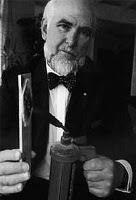
Unlike other refractory materials Starlite becomes toxic at high temperature as it is light extremely. It can be used in the construction of spacecraft, aircraft, fire-retardant suits, or in the military industry, but unfortunately, Starlite never left the laboratory: its founder Morris Ward died in 2011, the year did not patent his invention and leaving no descriptions . All that is known about the structure starlita - that it includes 21 organic polymer, more copolymers and a small amount of pottery.
5. Aerogel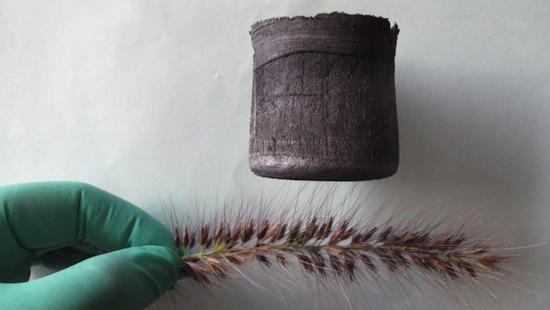
Imagine a porous material such a low density that 2, 5 cm³ it contains a surface comparable with the size of a football field. But it is not certain the material, but rather a class of substances: airgel - a form that may take some materials and midget density makes it an excellent insulator. If the window is made from a thickness of 2, 5 cm, it will have the same insulation properties as the glass window 25 cm thick.
All of the lightest in the world of materials - aerogels, for example, silica airgel (essentially dried silicone) only three times heavier than air and quite fragile, but it can support the weight in 1000 times greater than his own. Graphene airgel (shown above) is composed of carbon, and its solid component is seven times lighter than air: with a porous structure, this substance repels water but absorbs oil - it will be used to fight the oil slick on the water surface.
6. Dimethyl sulfoxide (DMSO) 65,085,698
This chemical solvent first appeared as a by-product of the pulp and is not applied until the 60-ies of the last century, when opened its medical potential: Dr. Jacobs found that DMSO can easily and painlessly penetrate the tissues of the body - it lets you quickly and without damage Skin introduce different drugs.
His own therapeutic properties relieve pain or sprains, such as inflammation of the joints in arthritis, DMSO can also be used to combat fungal infections.
Unfortunately, when his medical properties were discovered, the production on an industrial scale has long been established, and its widespread availability did not allow pharmaceutical companies to make a profit. Also from DMSO has an unexpected side effect - breath was using the human-like garlic, so it is mainly used in veterinary medicine.
7. Carbon nano-trubki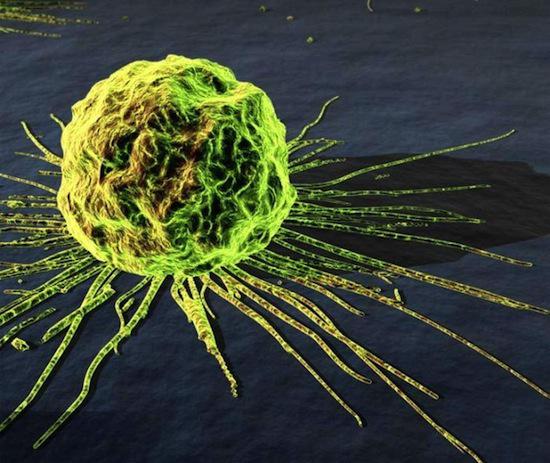
In fact, this sheet of carbon just one atom thick, rolled into cylinders - its molecular structure resembles a roll of wire mesh, and it is the strongest material known to science. At six times lighter, but a hundred times stronger than steel, nano-tubes have better thermal conductivity than diamond and conduct electricity more efficiently copper.
Sami tube are not visible to the naked eye, and unprocessed material resembles soot: to exhibit its unusual properties, it is necessary to force to rotate trillions of these invisible threads, which became possible only recently.
The material can be used in the production of cables for the project "elevators into space", designed for a long time, but until recently totally fabulous because of the inability to create a cable length of 100 thousand km, not be bent over under its own weight.
Carbon nano-tubes to help in the treatment of breast cancer - they can be placed in every cell in the thousands, and the presence of folic acid makes it possible to identify and "grab" cancers, then the nano-tube is irradiated by an infrared laser, and the tumor cells are killed at the same time. Also, the material can be used in the production of light and strong body armor ...
8. Paykerit
In 1942, the year before the British faced the problem of shortage of steel for the construction of aircraft carriers, needed to combat German submarines. Geoffrey Pyke proposed to build a huge floating airports of ice, but it did not pay off: ice, though inexpensive, but short-lived. Everything changed with the opening of the New York scientists unusual properties of a mixture of ice and sawdust that strength was like a brick, and does not crack and does not melt. But the material can be processed like wood or melt like metal filings swell in water to form the shell and preventing the melting of ice, due to which any vessel can be repaired directly during the voyage.

But with all the good qualities, pykrete was unsuitable for efficient use: for the construction and the creation of ice vessel weighing 1,000 tonnes was enough engine power to one horsepower, but at temperatures above -26 ° C (and for maintaining it requires a complex cooling system ) ice tends to sink. In addition, cellulose used in the manufacture of paper was in short supply, so pykrete remained impractical design.
9. BacillaFilla - Construction mikrob
Concrete has the property of "tired" with time - it becomes a dirty gray, and it cracks. If we are talking about the foundation of the building, the repair can be quite time consuming and expensive, with no guarantee that it will eliminate the "tired": many of the buildings being demolished because it was impossible to restore the foundation.
A group of students at Newcastle University has developed a genetically modified bacteria that can penetrate into deep fissures and produce a mixture of calcium carbonate and glue, strengthening the building. Bacteria are programmed so that they are distributed over the surface of the concrete until they reach the edge of yet another crack, and then begins the production of cementitious material, there is even a self-destruct mechanism of bacteria, prevents useless "build-up».
This technology will reduce anthropogenic emissions of carbon dioxide into the atmosphere, because the 5% of its production makes it concrete, and with its help will be extended the service life of buildings, restore them in the traditional way would cost a large sum.
10. Material D3o
Resistance to mechanical stress has always been one of the main problems of materials science, is not invented D3o - a substance whose molecules are in free movement under normal conditions and are recorded at impact. D3o structure resembles a mixture of cornstarch and water, which sometimes fill the pools. Special jackets made from this material, comfortable and provides protection in the fall, a hit batsman, or fists, that you may get, are already commercially available. Protective elements are not visible from the outside, that is suitable for stunt, and even the police.
via factroom.ru
1. One-way bulletproof steklo

In the richest people have problems judging by the growing sales of this material, they need bulletproof glass, which would have saved lives but did not stop them to shoot.
This glass stops a bullet on the one hand, but at the same time transmits the other - this unusual effect is a "sandwich" of fragile acrylic layer and a soft elastic polycarbonate: pressurized acrylic behaves like a very solid material, and in contact with the bullet he it dampens the energy of cod while. This allows the cushioning layer withstand the impact of bullets and shrapnel acrylic, without destroying.
When fired, the other side of the resilient polycarbonate bullet passes through a stretching and destroying fragile acrylic layer that leaves no further barrier for bullets, but do not shoot too often, because of this, to protect the formed hole.
2. Liquid glass
There was a time when the dishwashing detergent did not exist - people are treated with soda, vinegar, silver sand, friction or wire brush, but the new facility will help save a lot of time and effort and generally leave washing dishes in the past. "Liquid glass" includes silicon dioxide, is formed by reacting with water or ethanol material which then dries up, turning into a fine (more than 500 times thinner than a human hair) of the elastic layer, sverhstoykogo, non-toxic and moisture repellent glass.
With such material eliminates the need for cleaning and disinfecting agents, since he is able to perfectly protect the surface from germs: bacteria on the surface of the dish or just shells isolated. The invention also finds application in medicine, for sterilized instruments can now be only with the help of hot water, without the use of chemical disinfectants.
This coating can be used to combat fungal infections in plants and sealing of bottles, its properties are really unique - it repels moisture, disinfects, while remaining flexible, durable, breathable, and totally invisible and cheap.
3. Formless metal
This material allows golfers to hit the ball harder, increases the killing power bullets and prolongs the life of scalpels and engine parts.
Contrary to its name, the material combines the strength and toughness of the metal surface of the glass: in the video you can see how different deformation of steel and metal formless Falling metal ball. The ball leaves the steel surface a plurality of small "wells" - which means that the metal absorbs and dissipates the impact energy. Formless metal was smooth, then it is better to return the energy of impact, what also says longer rebound.
Most metals have ordered crystalline molecular structure, and the blow or other impact the crystal lattice is distorted, because of which remain on the metal and dents. The shapeless metal atoms are arranged randomly, so after exposure to the atoms return to their original position.
4. Starlite
This plastic that withstands extremely high temperatures: its thermal threshold is so high that at first did not believe the inventor. Only after demonstrating possibilities of the material live on television, with the creator starlita contacted employees of the British Atomic Weapons Center.
The researchers irradiated plastic flares heat capacity equivalent to 75-year-bombs dropped on Hiroshima - a sample is only slightly charred. One of the testers said: "Usually, between outbreaks have to wait a few hours to cool the material. Now we irradiate it every 10 minutes, but he remained unharmed, as if in mockery ».

Unlike other refractory materials Starlite becomes toxic at high temperature as it is light extremely. It can be used in the construction of spacecraft, aircraft, fire-retardant suits, or in the military industry, but unfortunately, Starlite never left the laboratory: its founder Morris Ward died in 2011, the year did not patent his invention and leaving no descriptions . All that is known about the structure starlita - that it includes 21 organic polymer, more copolymers and a small amount of pottery.
5. Aerogel

Imagine a porous material such a low density that 2, 5 cm³ it contains a surface comparable with the size of a football field. But it is not certain the material, but rather a class of substances: airgel - a form that may take some materials and midget density makes it an excellent insulator. If the window is made from a thickness of 2, 5 cm, it will have the same insulation properties as the glass window 25 cm thick.
All of the lightest in the world of materials - aerogels, for example, silica airgel (essentially dried silicone) only three times heavier than air and quite fragile, but it can support the weight in 1000 times greater than his own. Graphene airgel (shown above) is composed of carbon, and its solid component is seven times lighter than air: with a porous structure, this substance repels water but absorbs oil - it will be used to fight the oil slick on the water surface.
6. Dimethyl sulfoxide (DMSO) 65,085,698
This chemical solvent first appeared as a by-product of the pulp and is not applied until the 60-ies of the last century, when opened its medical potential: Dr. Jacobs found that DMSO can easily and painlessly penetrate the tissues of the body - it lets you quickly and without damage Skin introduce different drugs.
His own therapeutic properties relieve pain or sprains, such as inflammation of the joints in arthritis, DMSO can also be used to combat fungal infections.
Unfortunately, when his medical properties were discovered, the production on an industrial scale has long been established, and its widespread availability did not allow pharmaceutical companies to make a profit. Also from DMSO has an unexpected side effect - breath was using the human-like garlic, so it is mainly used in veterinary medicine.
7. Carbon nano-trubki

In fact, this sheet of carbon just one atom thick, rolled into cylinders - its molecular structure resembles a roll of wire mesh, and it is the strongest material known to science. At six times lighter, but a hundred times stronger than steel, nano-tubes have better thermal conductivity than diamond and conduct electricity more efficiently copper.
Sami tube are not visible to the naked eye, and unprocessed material resembles soot: to exhibit its unusual properties, it is necessary to force to rotate trillions of these invisible threads, which became possible only recently.
The material can be used in the production of cables for the project "elevators into space", designed for a long time, but until recently totally fabulous because of the inability to create a cable length of 100 thousand km, not be bent over under its own weight.
Carbon nano-tubes to help in the treatment of breast cancer - they can be placed in every cell in the thousands, and the presence of folic acid makes it possible to identify and "grab" cancers, then the nano-tube is irradiated by an infrared laser, and the tumor cells are killed at the same time. Also, the material can be used in the production of light and strong body armor ...
8. Paykerit

In 1942, the year before the British faced the problem of shortage of steel for the construction of aircraft carriers, needed to combat German submarines. Geoffrey Pyke proposed to build a huge floating airports of ice, but it did not pay off: ice, though inexpensive, but short-lived. Everything changed with the opening of the New York scientists unusual properties of a mixture of ice and sawdust that strength was like a brick, and does not crack and does not melt. But the material can be processed like wood or melt like metal filings swell in water to form the shell and preventing the melting of ice, due to which any vessel can be repaired directly during the voyage.

But with all the good qualities, pykrete was unsuitable for efficient use: for the construction and the creation of ice vessel weighing 1,000 tonnes was enough engine power to one horsepower, but at temperatures above -26 ° C (and for maintaining it requires a complex cooling system ) ice tends to sink. In addition, cellulose used in the manufacture of paper was in short supply, so pykrete remained impractical design.
9. BacillaFilla - Construction mikrob

Concrete has the property of "tired" with time - it becomes a dirty gray, and it cracks. If we are talking about the foundation of the building, the repair can be quite time consuming and expensive, with no guarantee that it will eliminate the "tired": many of the buildings being demolished because it was impossible to restore the foundation.
A group of students at Newcastle University has developed a genetically modified bacteria that can penetrate into deep fissures and produce a mixture of calcium carbonate and glue, strengthening the building. Bacteria are programmed so that they are distributed over the surface of the concrete until they reach the edge of yet another crack, and then begins the production of cementitious material, there is even a self-destruct mechanism of bacteria, prevents useless "build-up».
This technology will reduce anthropogenic emissions of carbon dioxide into the atmosphere, because the 5% of its production makes it concrete, and with its help will be extended the service life of buildings, restore them in the traditional way would cost a large sum.
10. Material D3o
Resistance to mechanical stress has always been one of the main problems of materials science, is not invented D3o - a substance whose molecules are in free movement under normal conditions and are recorded at impact. D3o structure resembles a mixture of cornstarch and water, which sometimes fill the pools. Special jackets made from this material, comfortable and provides protection in the fall, a hit batsman, or fists, that you may get, are already commercially available. Protective elements are not visible from the outside, that is suitable for stunt, and even the police.
via factroom.ru
Round tables set up on a friendly footing, and square and rectangular - competition
Experts say that the symbiosis of people and cars waiting for us already this century




